Meetings are the lifeblood of every company. They facilitate important moments where we meet with colleagues to make decisions, generate ideas, share, and discuss.
Are your meetings as productive and engaging as you’d want them to be? If you think there’s room for improvement, get inspired by this collection of 25 best meeting tips Slido swears by.
We have divided these into small steps you can do before, during, and after your meeting.
📋 Before the meeting
#1. Dedicate enough prep time to each meeting
A great meeting starts before the meeting. Spend time designing a meeting that makes sense from the first minute to the last. When it comes to meetings, winging it almost never pays off.
💡In their book ‘How to fix meetings’, G. Allcott and H. Watts advise applying a 40-20-40 rule to meetings: 40% spent on prep phase, 20% in a meeting, and the remaining 40% is for productive follow-through.
Here’s a step-by-step guide on how to prepare for meetings.
#2. Be clear on the meeting purpose
Drill down on what the real purpose of the meeting is. Are you meeting to brainstorm, share an update on past performance, plan the future, or enforce relationships?
Identify your main goal and stick to it. If it’s to make a decision about X, don’t leave the meeting without seeing it through. If you set one clear objective, it’ll be much easier for you to design an agenda for your meeting too.
PS: If you’ve got a number of goals, consider hosting multiple meetings.
#3. Loosen up the agenda
Don’t try to cover too much in one meeting. A simple agenda goes a long way – sometimes all you need is a list of discussion points that you want to touch on during the meeting. This will hold your meeting together like a skeleton. The most important things to add to your agenda:
✅ Purpose of the meeting
✅ The length of the meeting
✅ The expected meeting outcomes
✅ The main discussion points
✅ People who will present at the meeting
✅ Supporting documents & materials
Find more on the topic of crafting a meeting agenda here. Or if it’s all-hands you’re interested in, see this article where we talk about all-hands meeting agenda.
#4. Share the agenda with everyone involved in advance
Especially if it’s an important meeting, let every attendee know what it will be about well in advance (1-3 days).
You’ll set the right expectations and allow everyone to prepare for the meeting. You can simply share the meeting agenda via your internal comms channels such as Webex, Slack, or Microsoft Teams, and/or attach it to a meeting invite.
#5. Write smarter meeting invites
Add all the important information to the meeting invite so that nobody can miss it.
✅ Paste the meeting agenda in the description.
✅ Attach the link to the video conference.
✅ Invite everyone who’s essential for reaching the meeting outcomes.
✅ Consider inviting optional people – anyone who might benefit from the meeting as well.
💡Keep the link to the video conference always in one place – for example, attached to the meeting invite. This way, you’ll make it easier for remote participants to join as they will always know where to go looking for it.
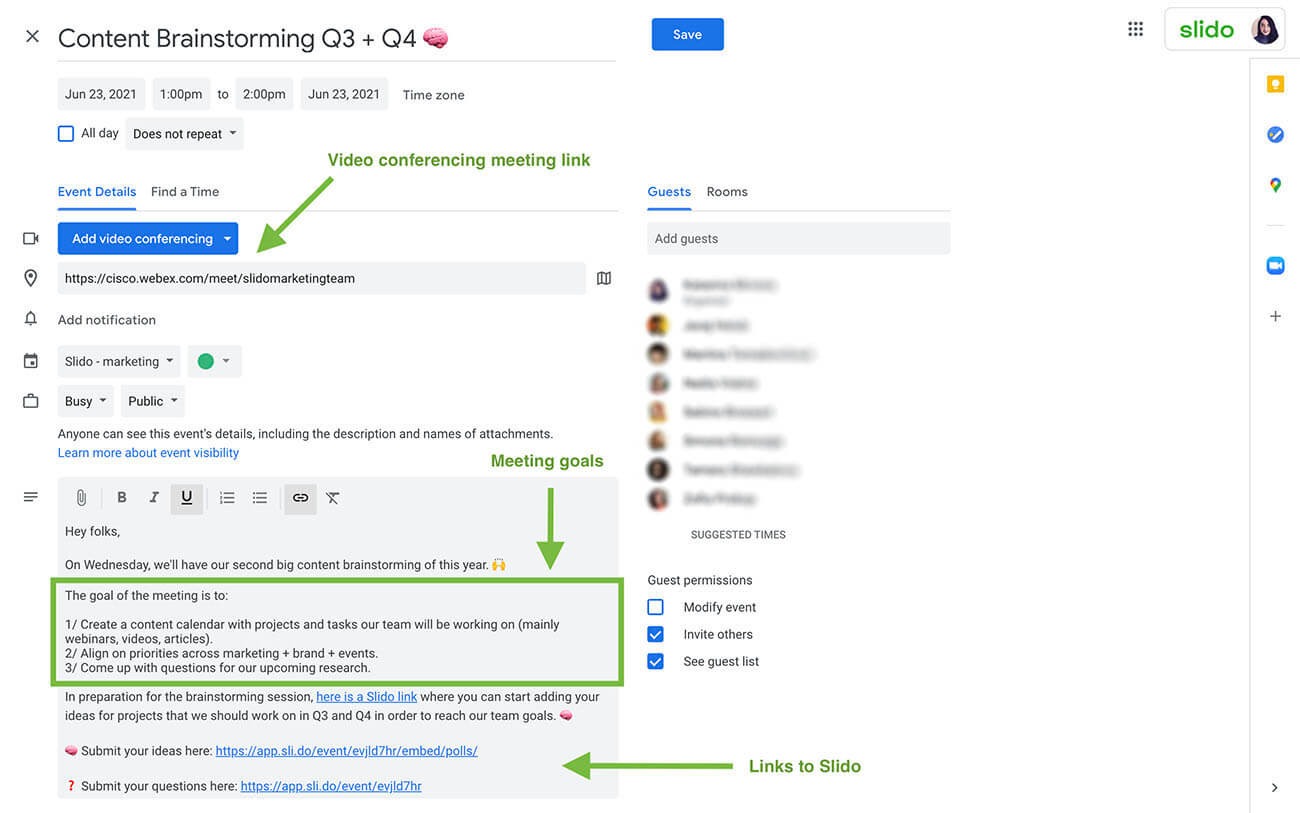
#6. Collect input from people in advance
Some meeting formats can really benefit from gathering input from your team members before the meeting.
For example, send out a Slido survey a few days before your team retrospective to better prepare and learn what your teammates think. Or, start collecting ideas before your brainstorming session via a Slido open text poll – your colleagues will have more time to think about the topic in private and come up with even better ideas.
#7. Create multiple opportunities for interaction
When designing your meeting, go through your agenda and think about where it makes sense to bring your colleagues in and give them a voice. Take inspiration from our Education Manager, Sabine Brossart, who says:
“Start simply & work your way up gradually. I like to start with an icebreaker. Throughout the meeting, I ask for people’s opinions or ideas, do live voting to learn what people think, and close with a feedback survey.”
Read also: Interaction is the tip of the meeting iceberg
📅 During the meeting
#8. Lighten up the mood with a fun warm-up poll
Start your meeting with a thought-provoking ‘would you rather’ poll or a cool word cloud. Ask people about their submissions, discuss them aloud, and share some jokes – even if the main meeting content is serious. It will help encourage people to engage and speak up!
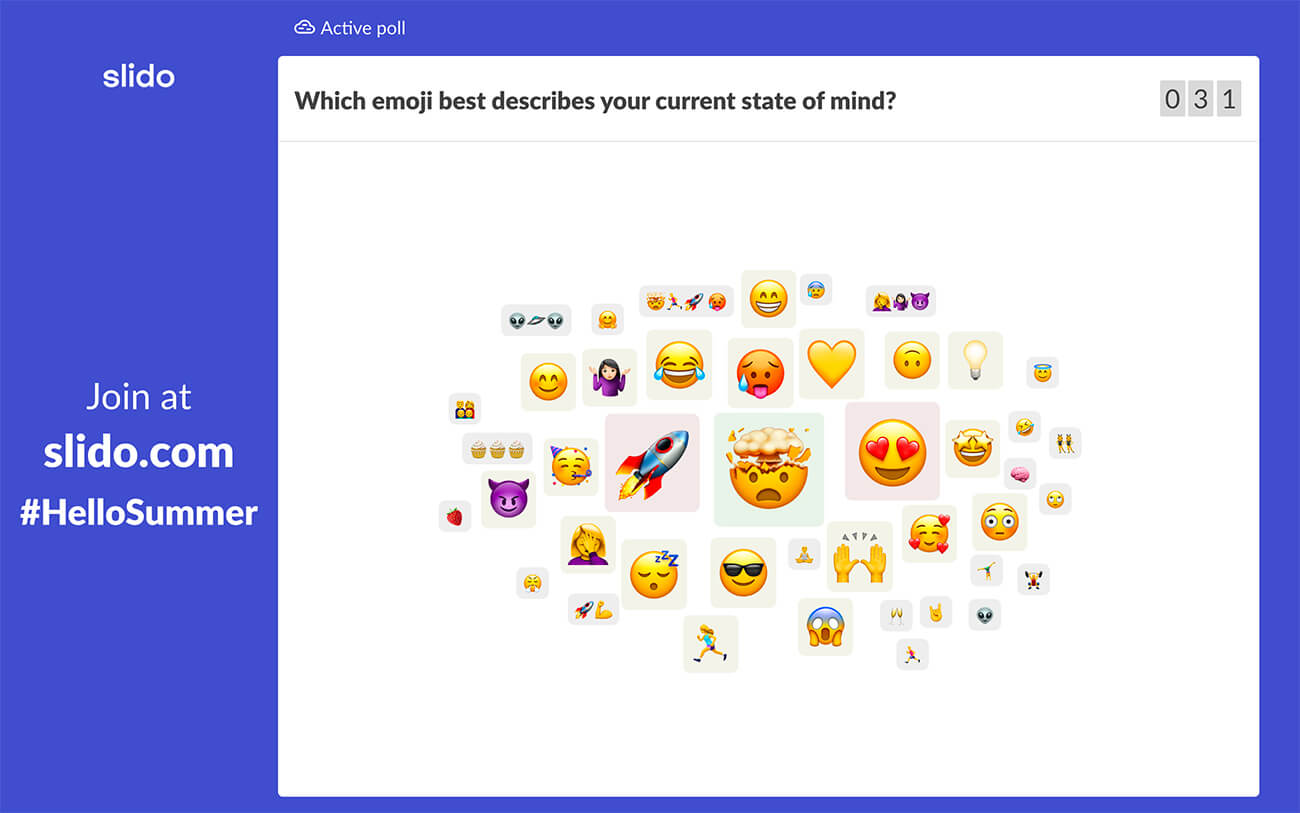
Would you like to recreate this tactic? Try Slido for free and take advantage of polls at your meetings.
#9. Don’t forget about team building
Being in a remote or hybrid setup, meetings are often the only place where the whole team gets together. Our Head of Scale Team, Luba Stubnova, advises:
“To make up for the lack of personal touch, I try to dedicate 10-15 minutes of my meetings to various small team-building elements to create connection and build trust. It can be a little chit-chat as we all tune in, get-to-know-each-other polls or short weekly team reflections.”
Read also: 7 Super Engaging 5-Minute Team Building Activities for Your Meetings
#10. Run a quiz to get to know each other better
Who doesn’t love quizzes? Host one as part of your meeting or run a stand-alone team-building session. Our two absolute favorites are two truths and one lie and team trivia.
Every team is a bit like a family, with their own quirks, internal humor, or stories; you must have plenty of those as well. Collect them for a fun quiz and learn who knows your team the best!
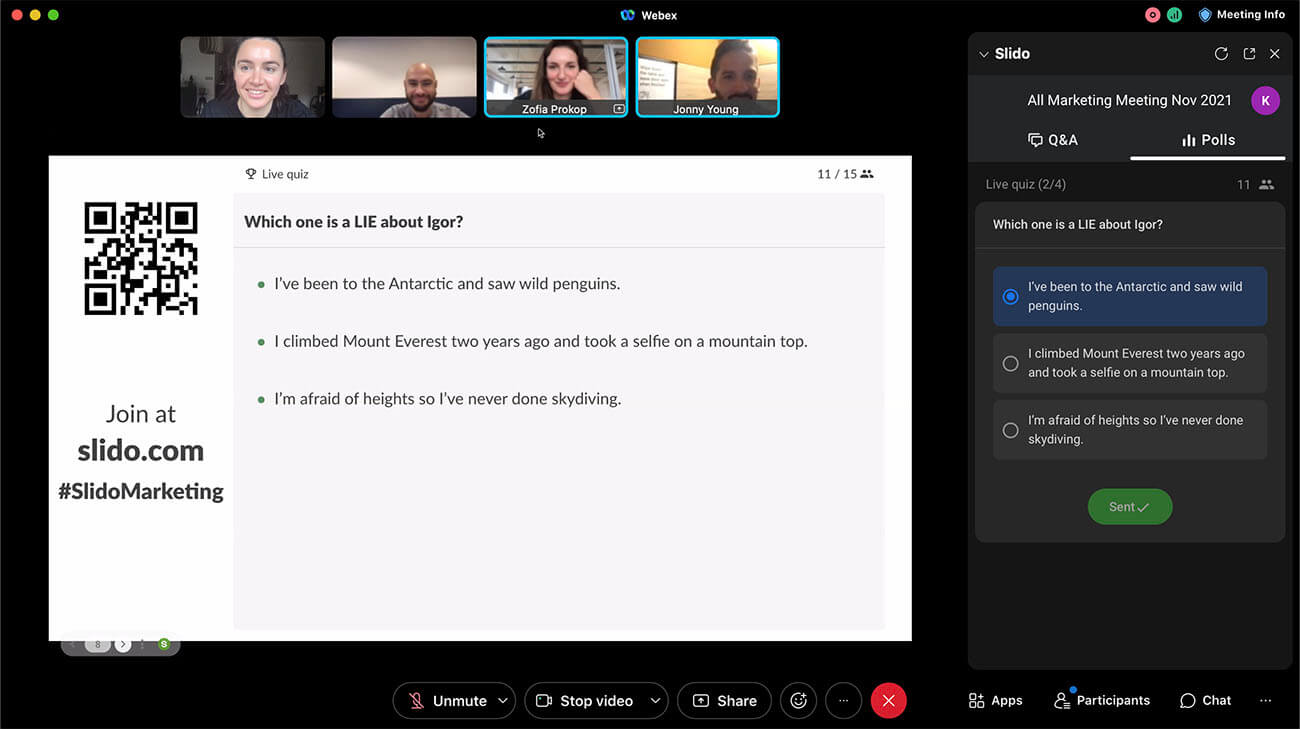
Read also: Step-by-Step Guide for Hosting a Great Online Quiz
#11. Try to include everyone in a conversation
Be inclusive of everyone – the silent ones as well. Keep an eye on the participants. If someone hasn’t said anything for too long, invite them into the discussion.
Follow the advice of our Chief Meeting Designer, Juraj Holub: “Be mindful of subtle cues. If you spot anyone unmuting themselves or nodding, or changing their facial expression, it’s your chance to bring that person in.”
#12. Embrace the power of occasional silence
Silence is an empowering asset. If there’s always someone talking at all times, your less assertive colleagues won’t have the chance to join in. Carve out time for them to speak. Make strategic pauses to give people some silent time to process information and speak up.
Silence can be your ally also when it comes to brainstorming. As Liana Kreamer and Steven G. Rogelberg say here: “Silent brainstorming [or brainwriting] produces significantly more ideas than brainstorming out loud — and these ideas tend to be more creative and of higher quality.”
Read also: How to deal with awkward silences during meetings
#13. Delegate responsibilities and tasks
Here’s an engagement tip from a seasoned facilitator, and the host of the First Time Facilitator Podcast, Leanne Hughes:
“One of the easiest ways to build engagement is to give people roles. If you have group meetings with over 10 people, delegate responsibilities. Appoint different meeting owners or assign accountabilities across the group – such as timekeepers, note takers, or guest speakers.”
#14. Give everyone a safe space to ask questions
People often shy away from asking questions at meetings. They may be worried about looking silly in front of their colleagues or may not feel comfortable speaking up.
Allow your meeting participants to ask questions safely through a Q&A app. They will simply type their questions into an app – even anonymously if they wish to.
Read also: Why Psychological Safety is Essential for Performance in the Workplace

#15. Become a slides-minimalist
Take the minimalist approach to your slide design – one piece of information per slide is easier to follow than huge bodies of text and is more visually appealing. Cut the number of slides too.
Rather than going through a seemingly endless presentation, trigger a fruitful discussion!
#16. Have one master slide deck
If there are multiple people presenting at the meeting, share a collaborative slide deck so that anyone can add their slides in, or collaborate on the content together.
It’s also more practical when you share the screen – you’ll just keep sharing one presentation deck.
Read also: Multiple Presenters? Here’s How to Run Your Virtual Meeting Without a Glitch
#17. Endless discussions? Vote in a poll!
Are you going around in circles? Cut down the decision-making time with live polling. Put up a Slido poll and let people vote for their preferred option.
You’ll see the results instantly and save plenty of meeting time. Plus, it’s more democratic because you’ll hear from everyone – not just a few vocal individuals!
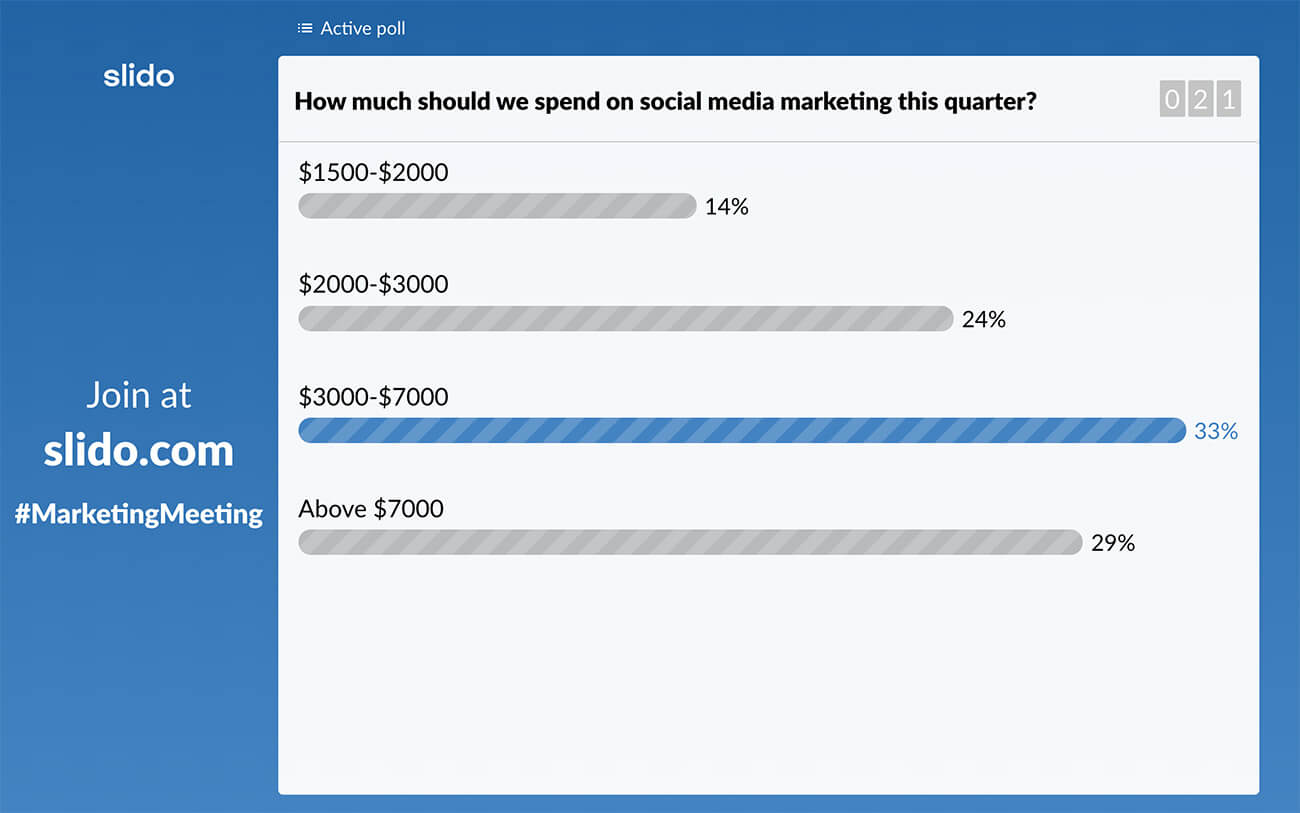
#18. Make interacting with your colleagues ridiculously easy
Run interactive polls, quizzes, and Q&A directly within your Webex Meetings using the Slido app in your Webex. You’ll simply create the poll or a quiz in the sidebar and your colleagues will vote or submit their answers right within their Webex.
If you don’t use Webex, you can add Slido directly to your Microsoft Teams meeting, Google Slides, or PowerPoint presentation and engage with your meeting attendees as you present.
#19. Collect your team’s feedback & opinions
If you don’t happen to have a crystal ball, it’s hard to know what’s on your teammates’ minds. But you can ask.
Use polls to learn whether your team’s on board with a decision. Ask how well your team understands a new strategy. Send out a feedback survey after your meeting to learn what your colleagues found valuable and what could be improved. It’s priceless!
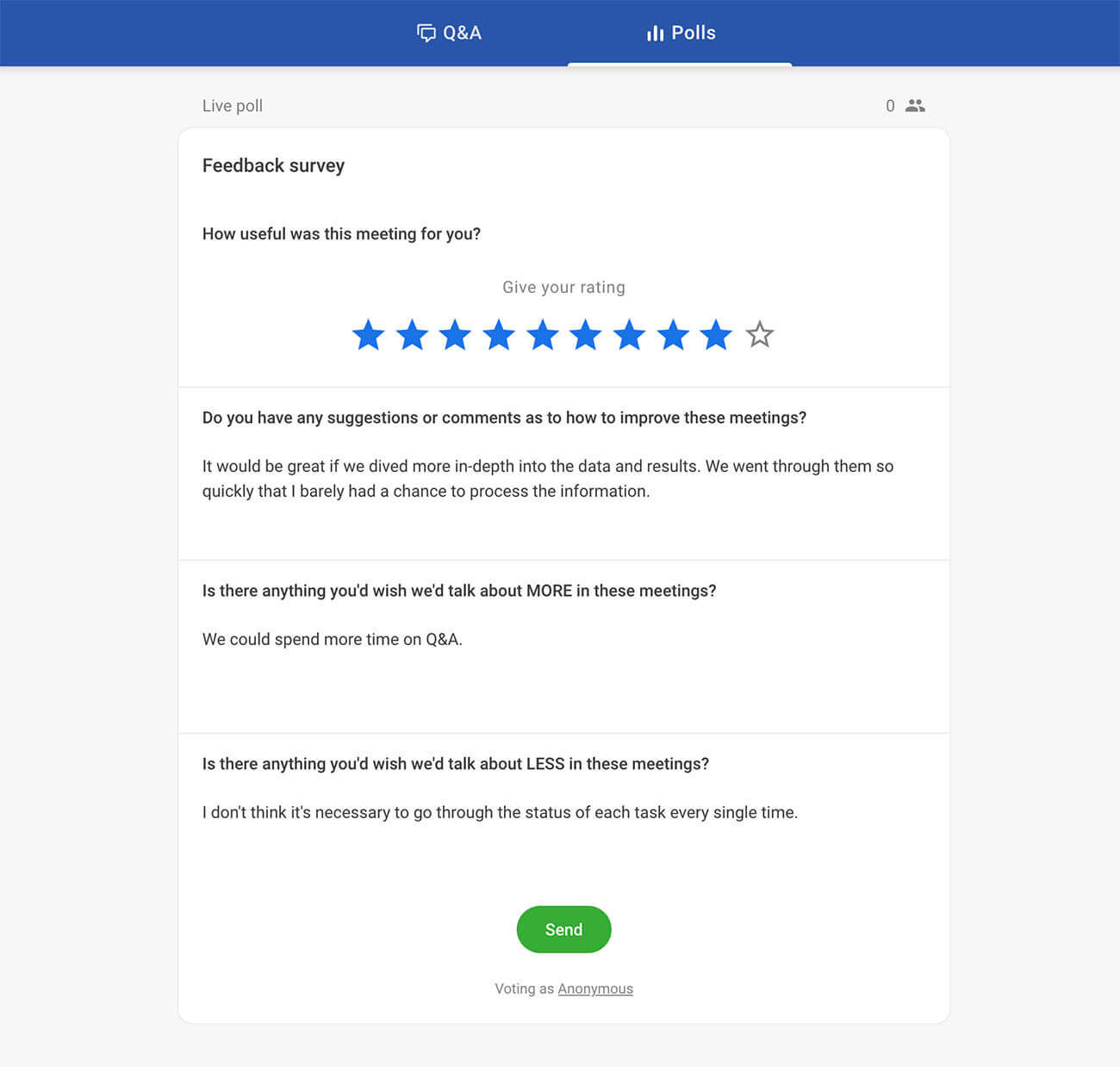
#20. Share the feedback survey while people are still on the call
We rate Uber rides as we’re stepping out of the car – we don’t wait until we get home.
Share a feedback survey at the end of your meeting and ask people to fill it out while they are still there. This will boost the response rate and you’ll have much more material to work with!
Read also: Post-meeting Feedback Survey: A Way to Measure Your Meeting’s Effectiveness
🏁 After the meeting
#21. Don’t just ask for feedback – act on it!
After the meeting, read what your teammates wrote and try to implement their suggestions in your upcoming meetings. Feedback is an asset to keep improving your meetings.
#22. Move important meetings to a special venue
If there’s an important all-company meeting coming up, such as an all-hands meeting, town hall, or a company offsite, consider booking a special venue for it.
Of course, you can do this in-house, but where’s the sense of occasion? It’s easy to say you care about company culture. But going to the effort of booking an external site doesn’t just say it. It shows it. Plus, a venue is another way of expressing your company identity: contemporary or historical, quirky or minimal, there’s a shoe for every foot.
You’ll find many great venues available for booking on Spacehuntr. For close-knit teams, meeting rooms do perfectly. For larger groups, something like a conference room might be in order.
#23. Master asynchronous communication
If you operate in a hybrid setup or are a globally distributed team, the async way of working can really work for you. It allows you to reduce the number of meetings, save time and it’s also more inclusive for it helps remote workers or childcare providers who can’t always make it to a meeting stay informed and have an equal opportunity to have a say.
Take the full advantage of your internal communications channels, run asynchronous feedback rounds, vote on important items or discuss – you can do all that asynchronously. Be sure to read the article below where you’ll learn plenty of useful tactics.
Read also: Asynchronous Communication: What It Is and How to Do It Well
#24. Allow people to post their input anonymously
Anonymity affords people more freedom to express themselves, be honest, and offer more unorthodox ideas they’d otherwise hesitate to voice out loud.
If you’re using a tech tool for crowdsourcing ideas from your team, or collecting questions for a Q&A, pick one that allows people to stay anonymous if they wish to. With Slido, people can ask, vote or share without having to put their names to their submission.
To know more, read Why Anonymous Feedback Helps to Improve Trust in the Workplace
#25: Don’t forget about people who cannot attend
Is your team spread all across the world? Then chances are, that not everyone will always be available to attend this or that meeting – whether they’d be in a different time zone, or have other priorities at the time.
Still, you can show that you care about their input. Invite the people who won’t be able to attend the meeting to post their ideas into a tool like Slido before the meeting (see also point #6).
This way, you’ll be able to address their ideas during the meeting and your colleagues will feel included in the discussion when they watch the recording later.
PS: Don’t forget to press ‘Record’!.
Ready to take your meetings to the next level?
Running meetings is hard. Running great meetings is even harder. But with the 25 meeting tips that we’ve shared above, we dare say you’ll get closer to hosting stellar meetings that people will love to attend.
From preparation hacks to interaction and engagement tactics to meeting facilitation – we hope you’re coming away inspired. And if you’ll want to create an even better meeting experience, go ahead and try Slido. It’s free.
PS: Need any help or want to discuss how Slido can help improve your meetings? Contact us. We’ll be happy to help you. 💚




